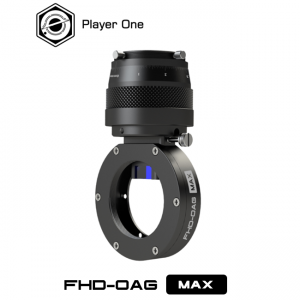The modular Rigel Systems Wifi-nSTEP, which has always been fully ASCOM compliant to work with popular astroimaging applications, now features ALPACA networking capability to connect wirelessly using its built-in wifi access point or through an observatory wifi access point.
 As Dr. Leon Palmer of Rigel Systems notes, “In the ever-evolving field of astro-photography where fast optics and advanced camera devices are essential, maintaining accurate focus is critical. Wifi-nSTEP’s built-in web server provides full integration into Alpaca that enhances the user experience by providing fast, reliable, and precise focusing of your telescope from an Alpaca dynamic client as well as control and monitoring from any device with a web browser such as a smart phone or tablet.”
As Dr. Leon Palmer of Rigel Systems notes, “In the ever-evolving field of astro-photography where fast optics and advanced camera devices are essential, maintaining accurate focus is critical. Wifi-nSTEP’s built-in web server provides full integration into Alpaca that enhances the user experience by providing fast, reliable, and precise focusing of your telescope from an Alpaca dynamic client as well as control and monitoring from any device with a web browser such as a smart phone or tablet.”
He continued, “And of course, the wifi-nSTEP retains its capability to directly connect to a Windows PC and ASCOM clients through Microsoft’s Component Object Model (COM) using a USB cable as before and, as always, using its built-in dual speed focusing buttons.”
Alpaca Dynamic Clients are built into the ASCOM Platform and can be created on demand through the ASCOM Chooser. These dynamically created clients will be configured automatically using information from Alpaca devices such as the Wifi-nSTEP that identify themselves over the network using the Alpaca discovery protocol. They will also attempt to “self-heal” by rediscovering an Alpaca device if its IP address changes and will also discover and communicate with Alpaca devices using IPv4 and IPv6
Alpaca provides simple point-to-point universal connectivity network protocol within an observatory between client applications and devices in the same way that COM does in classic ASCOM which has been a fundamental cornerstone of astronomy innovation on the Windows platform. NWith ASCOM Alpaca, the wifi-nSTEP has a new way to accomplish the same things but via network connectivity and on any platform, even embedded controllers. Both Alpaca and Classic ASCOM seamlessly operate in the background of many of the products you are currently using. Both provide the same universal language so that any astronomy app/program can connect to any astronomy device which complies with the ASCOM standards.
As Palmer also notes, “The Wifi-nSTEP is a modular approach to automating focusing. Our family of focus systems have been in production since 2010 with over 1000’s of installs on over 100 different types of focusers and always fully compatible with the most advanced Autofocus software using ASCOM and INDI drivers. Temperature compensation during focusing is also supported with the included temperature sensor.”
The Wifi-nSTEP uses gear coupling of stepper to focus shaft to provide up to 9,600 steps per revolution of the focus knob in full step mode and 19,200 in half step mode required for very fine focus control of fast telescopes and camera lenses – a focusing finesse far superior the 3200 to 5760 steps provided by shaft coupled systems. An additional advantage is gear coupling lets the user quickly and easily declutch the stepper motor to manually adjust focus using the coarse and fine focus knobs.
And, as Palmer also notes, “unlike “all in one” devices where if one internal component fails the entire device fails, the modular wifi-nSTEP allows easy repair or replacement of just the failed component, as well as an affordable upgrade path to more nSTEP features and online firmware improvements that can be wirelessly loaded. Sharing the wifi-nSTEP between telescopes is as simple as addition of an inexpensive bracket and gear tailored to each telescope’s focuser.”
You can learn more about the Rigel Systems Wifi-nSTEP ALPACA Compliance here.

 And to make it easier for you to get the most extensive news, articles and reviews that are only available in the magazine pages of Astronomy Technology Today, we are offering a 1-year magazine subscription for only $6! Or, for an even better deal, we are offering 2 years for only $9. Click here to get these deals which only will be available for a very limited time. You can also check out a free sample issue here.
And to make it easier for you to get the most extensive news, articles and reviews that are only available in the magazine pages of Astronomy Technology Today, we are offering a 1-year magazine subscription for only $6! Or, for an even better deal, we are offering 2 years for only $9. Click here to get these deals which only will be available for a very limited time. You can also check out a free sample issue here.
The Sun is more active than it’s been in years and if that’s not enough, we have the upcoming Total Solar Eclipse on April 8, 2024! If you’d like to learn more about the technology behind solar observing, solar imaging and more, you can check out our new monthly magazine – Solar Astronomy Today. It’s free to read, no subscription needed and available here. And if you are preparing for the upcoming eclipses and want to know your equipment options from solar glasses to the most out of this world solar viewing and imaging options, check out our free publication – The Definitive Guide to Viewing and Imaging the Sun – simply click here and enjoy reading!



